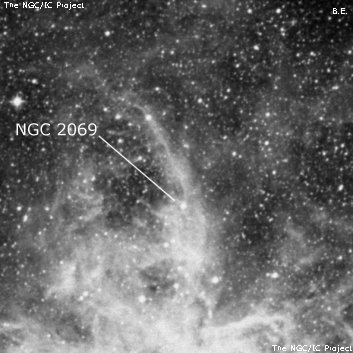
James Dunlop discovered NGC 2069 = D 143 on 3 Aug 1826 with his 9 reflector and noted a "A pretty large, faint, ill-defined nebula, elongated in the direction of the meridian." His position is 2'-3' too far north (unusually accurate for him). JH recorded h2940 on 24 Nov 1834 as "the middle of a large extended faint nebulous mass which forms the northern branch of the great looped nebula, and is almost, or entirely, detached from it. See the next object [Tarantula Nebula]."
400/500mm - 18" (7/8/02 - Magellan Observatory, Australia): this is the northern outer loop of the Tarantula Nebula which Dunlop and Herschel catalogued separately. Several mag 12-13 stars are involved, including mag 13.1 HDE 269926 (Brey 88), a massive Wolf-Rayet binary (WN4+OB). In addition, mag 11.1 HD 38282, an extremely massive Wolf-Rayet binary (Brey 89) is close east of the south end and HD 38344, another mag 13 WR star is 1.6' further E. See observing notes for NGC 2070.
Notes by Steve Gottlieb